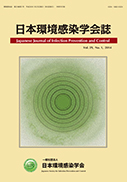Volume 30, Issue 4
Displaying 1-8 of 8 articles from this issue
- |<
- <
- 1
- >
- >|
Original Article
-
2015 Volume 30 Issue 4 Pages 243-248
Published: 2015
Released on J-STAGE: October 05, 2015
Download PDF (665K) -
2015 Volume 30 Issue 4 Pages 249-256
Published: 2015
Released on J-STAGE: October 05, 2015
Download PDF (805K)
Report
-
2015 Volume 30 Issue 4 Pages 257-261
Published: 2015
Released on J-STAGE: October 05, 2015
Download PDF (598K) -
2015 Volume 30 Issue 4 Pages 262-267
Published: 2015
Released on J-STAGE: October 05, 2015
Download PDF (961K) -
2015 Volume 30 Issue 4 Pages 268-273
Published: 2015
Released on J-STAGE: October 05, 2015
Download PDF (322K) -
2015 Volume 30 Issue 4 Pages 274-280
Published: 2015
Released on J-STAGE: October 05, 2015
Download PDF (867K) -
2015 Volume 30 Issue 4 Pages 281-287
Published: 2015
Released on J-STAGE: October 05, 2015
Download PDF (601K) -
2015 Volume 30 Issue 4 Pages 288-293
Published: 2015
Released on J-STAGE: October 05, 2015
Download PDF (826K)
- |<
- <
- 1
- >
- >|
